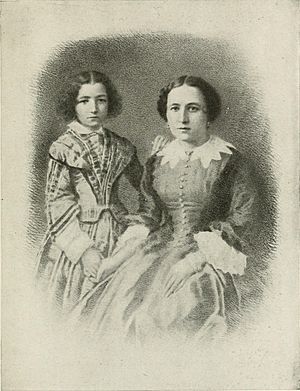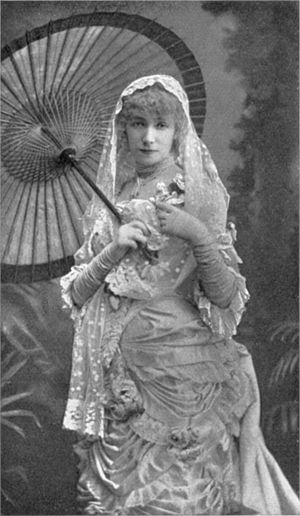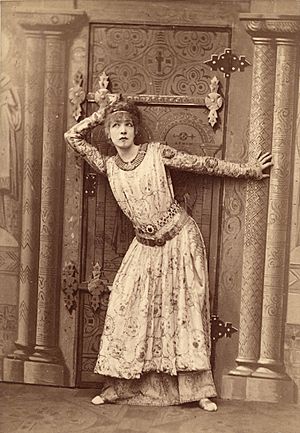Sarah Bernhardt facts for kids
Quick facts for kids
Sarah Bernhardt
|
|
|---|---|
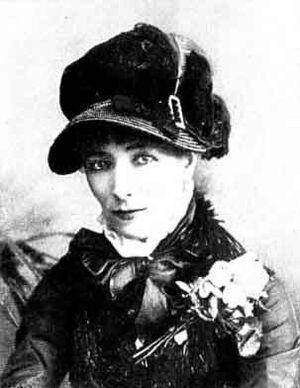
Sarah Bernhardt in June 1877, during a visit to Boston, Massachusetts
|
|
| Born |
Sara-Marie-Henriette Rosine Bernardt
October 22, 1844 |
| Died | March 26, 1923 (aged 78) Paris, France
|
| Years active | 1862–1923 |
| Spouse(s) | Ambroise Aristide Damala (1882–1889) |
Sarah Bernhardt (October 23, 1844 – March 26, 1923) was a famous French stage actress. Many people called her "the most famous actress in the history of the world." Bernhardt became well-known in Europe in the 1870s. Soon, she was performing in both Europe and the United States. She was known for her serious and powerful acting. People often called her "The Divine Sarah."
Contents
Sarah Bernhardt's Early Life
Henriette-Rosine Bernard was born in the Latin Quarter of Paris on October 22, 1844. Her mother was Judith Bernard. Her father was an attorney from Le Havre. Sarah later changed her name to Sarah Bernhardt.
Sarah's mother traveled often and did not spend much time with her daughter. She placed Sarah with nannies and in boarding schools. During this time, Sarah's mother made friends with important people. These included politicians, bankers, generals, and writers. One of her helpful friends was Charles de Morny, Duke of Morny. He was a family friend and the half-brother of Emperor Napoleon III.
In 1857, Sarah learned that her father had died. Her mother gathered the family, including Morny, to decide Sarah's future. Morny thought she should become an actress. She had already acted in plays at her schools. He arranged for Sarah to visit the Comédie Française. She went with her mother, Morny, and his friend Alexandre Dumas. During a play called Britannicus, Sarah cried very loudly. After the show, Dumas called her "my little star."
Morny used his influence to help Bernhardt audition at the Paris Conservatory. She studied acting there from January 1860 until 1862.
Her Acting Career Begins
After her time at the Paris Conservatory, Morny helped Bernhardt again. He got her a spot at the Théâtre Français. Her first show there was on August 31, 1862. It was not very successful. She felt stage fright and rushed her lines. Some people in the audience even made fun of how thin she was.
After two more plays, Sarah did not impress the critics. Other actors in the company also did not like how quickly she became famous. She was asked to leave when she was eighteen. She then became a backup actress for two main actresses at the Gymnase, another popular theater.
She was not successful at the Gymnase either. So, she decided to quit theater for a while and travel. She went to Spain and then to Belgium. Alexandre Dumas gave her letters of introduction. These letters helped her meet important people in society. She went to a masked ball in Brussels. There, she met Henri, Hereditary Prince de Ligne from Belgium. She later had a son named Maurice Bernhardt on December 22, 1864.
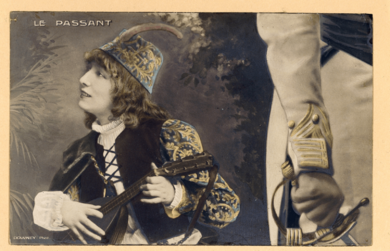
To support herself and her son, Bernhardt returned to acting. In 1866, Felix Duquesnel hired her. He was the director of the Théâtre de L'Odéon (Odéon). Her first few shows were not great. However, she got better with more experience.
Her big break came when she played the main female role in Alexandre Dumas's play Kean. Her next success was as a boy troubadour in François Coppée's Le Passant. This play ran for 150 performances. Emperor Napoleon III even asked for a special performance at his Tuileries Palace. Afterward, the emperor sent her a brooch with his initials made of diamonds.
In 1869, Sarah moved to a large seven-room apartment in Paris. Her mother started visiting. Her grandmother, who was a strict Orthodox Jew, moved in to help care for Maurice. Bernhardt also hired a maid and a cook.
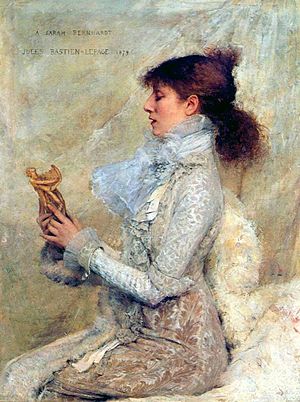
The Franco-Prussian War started, cutting Paris off from news and food. The theaters closed. Bernhardt took charge of turning the Odéon into a hospital with 32 beds. She brought her own chef. She also convinced her rich friends to donate supplies. By the end of the war, Bernhardt's hospital had helped over 150 wounded soldiers.
Many public buildings were damaged in the fighting. But the Odéon was still in good shape. Charles-Marie Chilly, the co-director of the Odéon, told her that theaters would reopen in October 1871. He asked her to play the lead in a new play. It opened on January 16, 1872. The Prince of Wales and Victor Hugo attended the opening night.
A few months later, Emile Perrin, Director of the Comédie Française, offered her more money. He wanted her to return to the Comédie Française. When Chilly would not match the offer, she broke her contract. She officially went back to the Comédie Française. Her role in Phèdre became her most famous classical part. She performed it around the world for many years. Even people who did not understand French could understand the play. She made them understand with her voice and actions.
Traveling the World to Perform
In April 1880, Bernhardt left the Comédie Française. A theater manager named Edward Jarrett quickly came to Paris. He suggested she go on a theater tour in England and then the United States. She could choose her plays and the actors.
Bernhardt's first American tour included 157 shows in 51 cities. She traveled on a special train. It had her own fancy sleeping car. This car carried her two maids, two cooks, a waiter, her head of dining staff, and her personal assistant. She always asked to be paid in cash. When Bernhardt returned to France, she brought a chest full of $194,000 in gold coins.
Bernhardt then started a series of world tours. The first tour went to French areas, Italy, Greece, Hungary, Switzerland, Belgium, Holland, Spain, Austria, and Russia. Just before this tour, she met Jacques Damala. He joined her as a leading actor and later became her husband.
Bernhardt's next world tour included Brazil, Argentina, Uruguay, Chile, Peru, Panama, Cuba, Mexico, Texas, New York City, England, Ireland, and Scotland. She was on tour for 15 months, from early 1886 to late 1887. This tour allowed her to buy her last home. She filled it with her paintings, plants, souvenirs, and animals.
From then on, whenever she needed money (which happened every three or four years), she went on tour. She performed her classic plays and new ones. In 1888, she toured Italy, Egypt, Turkey, Sweden, Norway, and Russia. She traveled the most during her 1891–92 tour. She went to much of Europe, Russia, North and South America, Australia, New Zealand, Hawaii, and Samoa. During this tour, she hurt her knee. She was supposed to land on a mattress after jumping from a balcony during a play, but the mattress was not in the right place.
Her Own Theater and Later Years
Bernhardt's debts kept growing. As she got ready for another world tour, she heard that a large Paris theater was available to rent. She decided to sign a 25-year lease with the city of Paris for the Théâtre des Nations. This was on Place du Châtelet. She signed it on January 1, 1899. She renamed the 1700-seat theater Théâtre Sarah Bernhardt. She then started to fix it up.
Bernhardt opened the theater on January 21, 1899. She performed her most successful plays there. In 1900, she put on a new play called L'Aiglon. In this play, she played Duc de Reichstadt, the son of Napoleon Bonaparte. The 56-year-old actress made the play very popular.
Even with her leg injury, she continued to tour every summer. This was when her own theater in Paris was closed. In September 1914, Bernhardt found that her leg had developed gangrene. A surgeon had to amputate her leg almost up to her hip. After this, she was carried in a special chair she designed. It had two long poles and was carried by two men.
She kept acting in Paris, even after losing her leg. The scenes were set up so she could sit. Or she could be supported by a prop with her leg hidden.
On March 21, 1923, she collapsed and never got better. She died on March 26, 1923. Her funeral was held at the church of Saint-François-de-Sales. The next day, 30,000 people came to her funeral to show their respect. A huge crowd followed her coffin from the church to Pere Lachaise Cemetery. They paused for a moment of silence outside her theater.
In 1960, Bernhardt was honored with a star on the Hollywood Walk of Fame. Her star is at 1751 Vine Street. She is the earliest born person on the Walk (born in 1844).
Sarah Bernhardt's Island Retreat
After her 1886–87 tour, Bernhardt rested on Belle-Île. This is a small island off the coast of Brittany. It is 10 miles south of the Quiberon peninsula. She bought a ruined 17th-century fort. It was at the end of the island and had a drawbridge. She turned it into her holiday home. She built small houses called bungalows for her many visitors. These included her son Maurice, her grandchildren, and her friends. She also brought her large collection of animals. She always wore white scarves. She played tennis (with rules that made her the winner) and cards. She read plays and made sculptures and decorations in her art studio. In 1922, her health got worse. She sold her part of the island and never went back. The Germans took over the land during World War II. All that is left now is the old fort and a seat cut into the rock. Bernhardt used to wait there for the boat to the mainland.
The Art of the Theatre
In her last years, Bernhardt wrote a book about acting. She wrote whenever she had time. This was usually between plays or when she was on vacation at Belle-Île. Her friend Marcel Berger found the unfinished book. He edited it and had it published as L'Art du Théâtre in 1923. An English version was published in 1925.
Interesting Facts About Sarah Bernhardt
- Sarah and her mother had rich and powerful friends. These friends helped her start her career in theater.
- Bernhardt played at least 70 roles in 125 plays. She played both female and male characters.
- She kept a satin-lined coffin in her bedroom. Sometimes, she slept in it or lay in it to study her roles.
- She had many exotic pets. These included a boa constrictor, a lion, a parrot, a puma, two horses, a monkey named Darwin, and an alligator named Ali Gaga.
- In 1910, she visited Thomas Edison. She recorded a scene from her most famous tragic role, Phèdre.
- Bernhardt was also a sculptor. She worked with many materials, such as bronze, marble, and ceramics.
- Her personal motto was “Quand même.” This means “no matter” or “so what?”
- During one performance, Emperor Napoleon III was in the audience. Bernhardt recited two poems by Victor Hugo. Hugo was a strong critic of Napoleon. The emperor got so upset that he left the theater. He took his wife, court, and other guests with him.
- When a theater doorman greeted her as “the little Bernhardt,” she broke her umbrella on his head.
- When the doorman retired 20 years later, Bernhardt bought him a cottage in the countryside.
- By the end of the 19th century, she was known as the most famous and richest actress.
- In 2001, Martha Stewart shared a recipe for Sarah Bernhardt cookies. She said they were as “multilayered as their namesake.”
Images for kids
-
Bernhardt as Mary Magdalene, painting by Alfred Stevens (1887)
-
Self-portrait 1910 Fondation Bemberg Toulouse
-
Bernhardt with her bust of Medea in her sculpture studio in Montmartre (c. 1878)
-
Debut of Bernhardt in Les Femmes Savantes at the Comédie Française, 1862
-
Sarah Bernhardt in 1864; age 20, by photographer Félix Nadar
-
Playing Joan of Arc in Jeanne d'Arc by Jules Barbier (1890)
-
Poster for Gismonda by Alphonse Mucha (1894)
-
As Melissande in La Princesse Lointaine by Edmond Rostand (1897)
-
Bernhardt in the role of Phedre at the Hearst Greek Theatre at the University of California, Berkeley (1906)
-
Bernhardt in the film Camille (La Dame aux camélias) with André Calmettes (1911)
See also
 In Spanish: Sarah Bernhardt para niños
In Spanish: Sarah Bernhardt para niños


